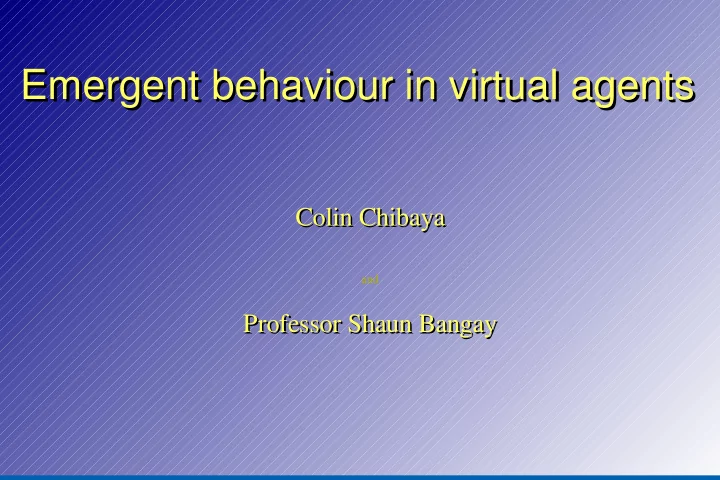

Emergent behaviour in virtual agents Emergent behaviour in virtual agents Colin Chibaya Colin Chibaya and Professor Shaun Bangay Professor Shaun Bangay
Research goal Research goal To investigate control routines for achieving emergent behaviour (what causes emergent behaviour?)
A probabilistic movement model for A probabilistic movement model for shortest path formation in virtual ant-like shortest path formation in virtual ant-like agents agents Two pheromone laying model (i) inspired by foraging ants in nature (ii) agents are simple, identical and unintelligent (iii) agents can only communicate through the environment. (iv) no global visibility, no lookahead or prior knowledge of the global position of the goal.
The problem The problem A number of factor influence robust path formation under changes in the environment. We investigate: (i) agent sensitivity to pheromone levels. The 3 strategies. (ii) pheromone dissipation. The different coefficients (iii) robustness and fault tolerance. Performance in the presence of obstacles.
Agent movement controls Agent movement controls foreach location L around agent If no obstacle on L R Ã rerturn pheromone at L S Ã search pheromone at L How do agent perceive sensitivity? if mode = search Pr(L) = P (S ; R) deposit return pheromone else Pr(L) = P (R ;S) deposit search pheromone else Pr(L) = 0 Choose direction probabilistically based on Pr(L) change mode on target
Pheromone perception strategies Pheromone perception strategies Strategy A: The desirability of a location L around agent is perceived as : the difference between levels of attractive and repulsive pheromone relative to the smallest level. Strategy B : The desirability of a location L around agent is perceived as: the quotient of levels of attractive and repulsive pheromone. Strategy C : The desirability of a location L around agent is perceived as : the product of levels of attractive and the complement of levels of repulsive pheromone.
Pheromone dissipation controls Pheromone dissipation controls foreach location L in the environment foreach pheromone at L P(L,i) Ã pheromone levels at L in iteration i S(L,i) Ã agents secretion at L in iteration i foreach neighbouring location n around L if P(n,i) > P (L,i) d(L,i) Ã γ P(n,i) Dissipation; from P(n,i) and secretion else d(L,i) Ã 0 P(L,i+1) Ã (1- γ)(1−ρ). P(L,i)+∑ n d(L,i)+S(L,i)
Experimental setup Experimental setup Directionality : (i) We preset path with pheromone levels increasing linearly (search: nest → goal and return: goal → nest) (ii) Ten thousand agents in each mode are recruited and orientation frequencies are recorded Path formation : Two metrics are of interest (i) Path formation speed:- measures the influence of attractive and repulsive pheromone level. Use iteration : search speed (start → first on goal → 10 on goal) return speed (goal → first on nest → 10 on nest) (ii) Path quality:-tendency to follow path. Compare trips made within 1000 iterations. More trips indicate use of define path Robustness and fault tolerance : Investigates path formation in an environment with obstacles. Establishment of an even shorter path when obstacles are removed from the scene
Results: Directionality Results: Directionality Performance Strategy A : Consistent in pheromone perception both when searching and loaded. 97% level of success. Strategy B : Directionality is weak in areas with higher repulsive pheromone. Does not tail off allowing unlikely cases to occur. 88% success Strategy C : weak, indistinguishable from random guess
Results: Path formation Results: Path formation Speed and quality : Strategy A : Generally fast with low evaporation(no dep) and high diffusion (grad). Best in speed and quality when ρ =0.0% and γ = 0.05%. Strategy B : Similar trends to A in early stages. Falls apart late in simulation due to drops in agent sensitivity repulsive pheromone levels Strategy C : Weak and indistinguishable from random guess
Results: Robostness and fault Results: Robostness and fault tolerance tolerance Performance Strategy A : Path formation is achieved relatively fast. Quality is good . When obstacles are removed-an even shorter path re-emerges Strategy B : Very slow in path formation. Poor quality path. Pheromone dissipation detrimental when path is long. [W.I.P] Strategy C : worse still when obstacles are included.
Conclusion Conclusion We propose a probabilistic movement model for controlling ant- like agents based on the use of two types of pheromone. Three strategies are investigated: Strategy A : Exhibit the best performance in all categories measured Strategies B and C : Weaknesses revealed in experiment that tested model robustness and fault tolerance. Contributions : Novel agent control model using two pheromones without any global information or agent look ahead Devised and evaluated three plausible strategies for simultaneously perceiving a pair of pheromone gradients into a direction vector Evaluated ways in which dissipation can influence the emergence of a path
End ?
Recommend
More recommend